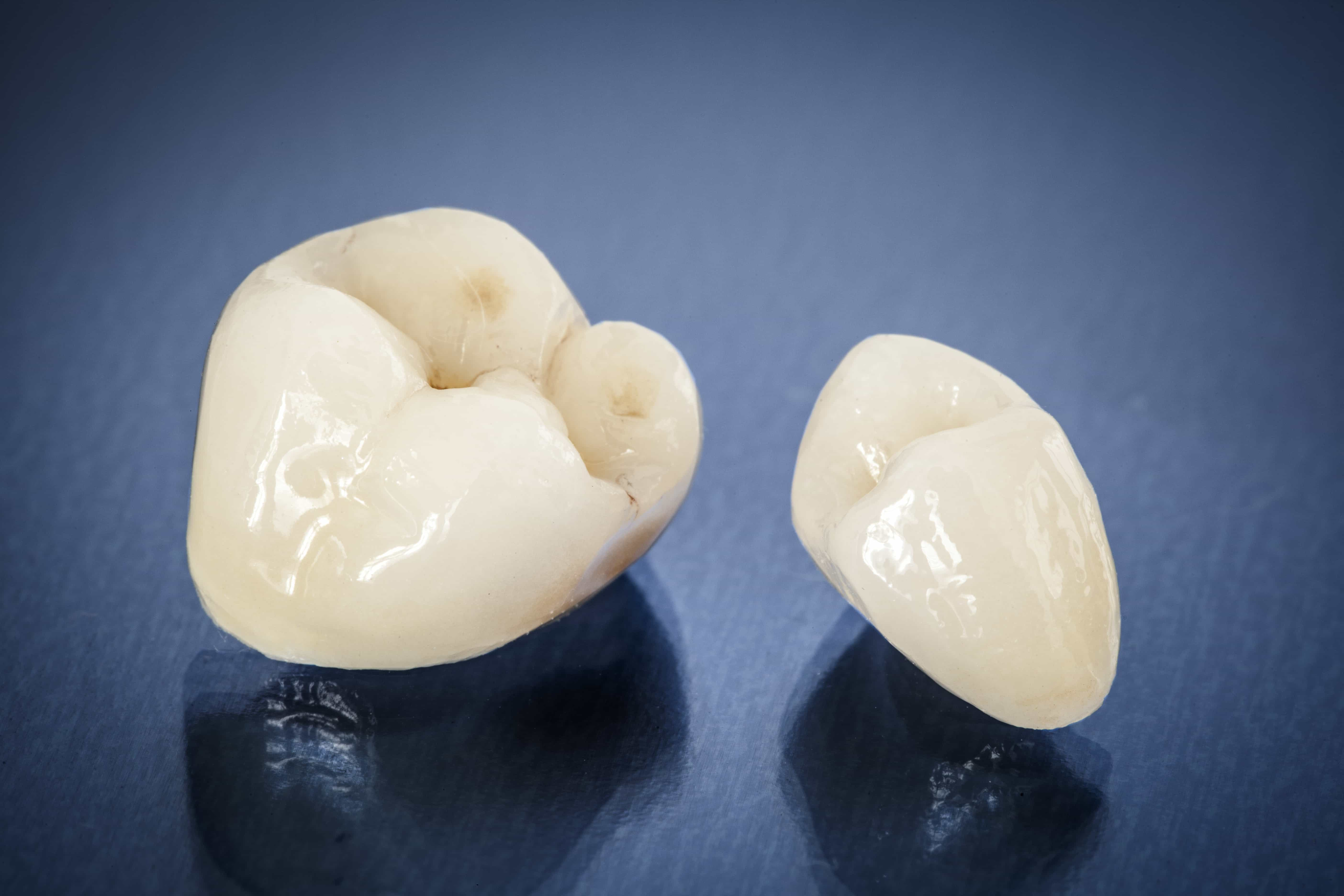Dental Crown In Houston, TX | Ceramic, Porcelain, & Gold Crowns
Dental crowns are a useful tool for dentists because they allow patients with diseased or damaged teeth to retain functionality. As technology advances, there are more dental crown options than ever before. Since there are several types of dental crowns, it can be useful to learn more about the materials used in their construction and the advantages and disadvantages of each type.
What Is a Dental Crown?
Crowns are used frequently in dentistry as a method of tooth replacement for patients whose natural tooth has become permanently damaged. Frequently, a crown is used to cover a tooth after a root canal has been performed. A dental crown is also used as a prosthetic in conjunction with a dental implant after a permanent tooth has been extracted.
Crowns are long-lasting solutions for damaged teeth but will eventually need to be replaced. When properly fitted by an experienced dentist and cared for according to the dentist’s instructions, crowns can last for a decade or more before needing to be replaced. One of the determining factors for longevity is the type of material used to construct the prosthetic. There are several different types of crown materials on the market, and your dentist can help you determine which type is best for your situation.
What Are the Different Types of Crowns?
Dental crowns are constructed from several different materials, and each type has its pros and cons. Although your dentist can give you an idea of what type of crown works best for your dental work, you can learn more about your options before scheduling the procedure. If you are a candidate for any type of crown, you may have a preference when it comes to appearance, durability, and budget. Most commonly, patients receive a porcelain, ceramic, metal, gold, acrylic, or alloy crown.
1. Gold and Metal Alloy Crown
Historically, crowns were often made with a gold alloy. Pure gold is too soft for a long-lasting solution, so it is combined with other metals to create a sturdy and reliable tooth replacement. Along with the durability, another advantage of a gold crown is the association with surrounding teeth. Gold is relatively soft, so it is less likely to cause damage to the tooth enamel of the surrounding teeth than other crown materials.
Despite being one of the most long-lasting options, most patients do not prefer the look of a gold crown on a visible tooth and choose a more subtle, realistic option instead. Gold typically does not cause an allergic reaction or sensitivity for most people, but since it must be combined with other metals for strength, patients can still be allergic to the alloy materials. Some sensitive to cold and heat patients may be more sensitive during the first few weeks after a gold crown is placed due to the way the metal alloy conducts temperature.
2. Porcelain Fused Onto Metal Crown
Patients who want to combine the qualities of gold or other material such as zirconia with the look of a more natural tooth can consider a fused crown. A porcelain fused to metal crown begins with a metal base and is covered with a layer of porcelain to give an appearance that more closely matches the surrounding teeth. A benefit of choosing this option is the combination of the durability of the metal without the obvious appearance of a crown.
Porcelain fused with gold may not be suitable for patients who are sensitive or allergic to alloys. If your gums are receding, you may see the metal color where the tooth meets the gumline. Some patients also prefer the look of a full porcelain crown because fused metal crowns require thicker porcelain and can appear more opaque.
3. 100% Porcelain Crown
When patients are trying to decide between different types of crowns, many immediately assume a full porcelain option is the right one for the situation. It’s true that a 100% porcelain option looks similar to a natural tooth and is more discreet than hybrid or metal crowns. Since they are one of the most attractive choices, they are also one of the most popular ones. Patients who are allergic to one of the metals commonly used in an alloy may have better success with a solid porcelain version. Porcelain is also suitable for individuals with heat and cold sensitivities since porcelain is not a good conductor.
Solid porcelain crowns do have a few disadvantages to consider. Since porcelain is stronger than natural tooth enamel, nearby teeth can become worn or chipped. This is especially a problem for people who grind or clench the teeth. An all-porcelain crown is also more likely to become damaged than metal or porcelain fused to metal varieties.
4. 100% Ceramic Crown
Another tooth replacement option to consider is a solid ceramic crown. Many of the benefits of a full porcelain crown also apply to the ceramic material. Your dentist may go into more detail to explain the advantages and disadvantages of ceramic over porcelain, but most patients who choose this option are looking for discretion. Ceramic tooth replacement looks like a natural tooth, both in color and in shape. The material is non-allergenic, unlike metal alloys used in other types of dental crowns. Patients with receding gums also prefer this type of construction because there is no chance of metal becoming exposed.
Some of the cons of ceramic dental crowns are the same as with porcelain crowns. Ceramic can cause premature wear on teeth that come in contact with the prosthetic. Ceramic also is more likely to become damaged. When ceramic or porcelain crowns break, they must be replaced since repair is usually not possible.
What Is the Process For Crown Placement?
Crowns are typically used for tooth replacement as either a cover for a damaged tooth or as an attachment to an implant for a missing tooth. Your dentist will first perform the procedure you need, such as a root canal or extraction. A root canal procedure leaves the tooth fragile, so it must be protected with a crown. In the case of extraction and subsequent implant, the process takes place during a series of appointments over several months with the crown as the final step.
When covering a damaged tooth, the tooth needs to be prepared by removing enough of the enamel for the crown to have a perfect fit. A mold is made of the prepared, and a temporary crown is attached. While you wear the temporary crown, your permanent one is manufactured, which usually takes at least two weeks. During a second appointment, the permanent crown is attached using dental cement and your dentist confirms a perfect fit.
Schedule a Visit With Ingenious Dentistry in Houston, TX
Houston area residents who need a dental crown can count on Ingenious Dentistry for experienced providers who provide high-quality dental work. Since several different dental concerns end with getting a dental crown, finding a practitioner you can trust is the first step toward restoring your smile. Using a dental crown guide to research your options can help you make a more informed decision when you visit your dentist for a consultation. If you have any questions about restorative dentistry or the different types of dental crowns that are available to patients, contact Ingenious Dentistry for more information. Call 713-795-5905 to schedule a visit with Dr. Dale J. Brant!
_________________________________________________________
_________________________________________________________
Reviews:
“Amazing experience from beginning to end every time. I actually look forward to my next visit to the dentist! I highly recommend Dr. Brant and his awesome staff to anyone!” – J.A.
“Love, love, love Dr. Brant and all of his staff! Very professional, thorough, and friendly. He has been treating me for many years and I’ve been so pleased with everything he has done. It’s a pleasure to visit their office!” – Rose S.
Other Dental Services at our Houston Dental Office
- General Dentistry
- Cosmetic Dentistry
- Sedation Dentistry
- Laser Dentistry
- Periodontal Disease Treatment
- Sleep Apnea Treatment
- Dr. Chao Pinhole Surgical Technique
- Dental Implants
Featured Image: Shutterstock / Sebra


